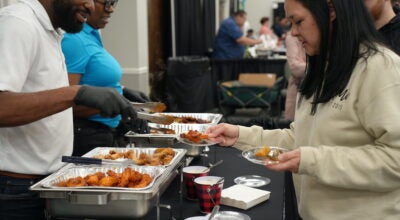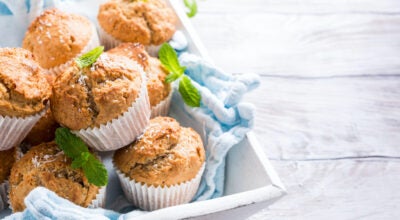Wholesome bites
Published 6:27 pm Wednesday, August 19, 2009
Victoria Laviolette is about to burst at 38 weeks pregnant.
Throughout her pregnancy she’s made efforts to eat right so her baby can get all the nutrients he needs to grow. When he is born and it’s time to feed him more solid food, she won’t go to the store to pick up jars of pureed baby food, she’ll make it at home.
“Making my own baby food is just one more way I can do what I feel is best for my child,” Laviolette said. “He will be getting pure food without all the additives and whatnot that is in store bought baby food.”
Laviolette learned about homemade baby food during a class dietician Robbie Lewis taught at St. Vincent’s One Nineteen.
Lewis prepared all of her daughter Annabelle’s baby food. For Lewis it became a necessity because Annabelle’s body can’t tolerate milk.
She said she also feels like she’s better protecting her daughter’s health.
“There is really no reason not to make her food,” Lewis said. “It’s cheaper, plus if you live off convenience foods you aren’t going to be able to provide your baby with the nutrients he or she needs.”
Laviolete originally thought making her baby’s food would be too time consuming. Running into a friend who did so for her own children changed her mind. She learned mixing up large batches at a time allows you to prep for a week or more.
Lewis said planning goes a long way.
“I have jars of baby food in the freezer,” she said. “I also always keep frozen whole-grain waffles around for breakfast and I keep food for her on me anytime we are away from home. Even if we do have to grab something quick, at least she will usually get some fruit or veggies to balance her meal out.”
Lewis said preparing baby food at home affords parents more control over ingredients used.
She focuses on limiting Annabelle’s salt, transfat and preservative intake.
“This is a brand new body,” Lewis said. “You don’t want to start altering the DNA with transfat right from the beginning.”
Laviolette hopes she can provide a fresher, more nutritious diet for her son as well. She also hopes doing so might prevent her son from being a picky eater.
“The food I make will actually taste like and smell like the actual food — some of the jars of baby food you can buy do not taste or smell like what is on the label,” Laviolette said. “My child will hopefully be exposed to a wider variety of foods — thereby making him a better eater as he gets older.”
Lewis thinks it would.
Annabelle loves sweet potatoes, mango and even avocado.
“I wonder if people think things like avocado are too sophisticated, but avocado is a perfect food for kids. It’s mushy and filled with healthy fat,” Lewis said. “If you put it in front of them with the look of, ‘Oh, you’re not going to eat that,’ chances are good they won’t.”
Lewis suggests starting out slowly. Introduce items like rice cereal and oatmeal first, she said. Then add other foods one at a time to test any probable food allergies.
At 7 or 8 months old, parents can incorporate fats such as peanut oils and extra virgin olive oil, Lewis said. She said it’s also essential to include Vitamin A foods and high-fiber ingredients such as lentils.
“I try to cook with super foods, because they’re super good for you,” Lewis said. “You need to be giving your baby foods packed with nutrients.”
Lewis said the mother’s were able to discuss their children’s allergy issues and how they’ve dealt with them.
She plans to lead her next class at One Nineteen Oct. 17 at 10 a.m. The class will cost $10, but will include samples.
SuperFood Casserole
*Adults and Babies 8 months
1 tsp olive or canola oil
1/2 onion
1-1/2 cup unsalted chicken broth
5 ounces chicken breast, no skin or bone
1 medium sweet potato or butternut squash, skinned and cubed
1 large apple, skinned and cubed
3 cups cooked brown rice, quinoa, or whole wheat pasta
1/2 cup unsweetened applesauce
water or baby’s usual milk (as needed for consistency)
To prepare chicken breast and unsalted chicken broth, cover chicken breast(s) with 1-1/2 cup water in a medium-sized pot. Boil chicken until done. In a large cooking pan, add oil and saute onion until clear. Add unsalted broth that was created from boiling chicken , cubed sweet potato or squash, and cubed apple to the pan. Cover and let cook approximately 10 minutes, or until potato/squash is soft. Cut chicken into pieces and add to mixture when ready; cook until chicken is heated through. Prepare brown rice, quinoa, or whole wheat pasta as directions instruct on their package. For adults, serve 1 cup chicken mixture over 1/2 cup rice/quinoa/pasta.
For baby, prepare dish as instructed. Place a combination of chicken mixture, pasta, unsweetened applesauce into a food processor. Add water or baby’s usual milk to mixture until you get the consistency necessary for baby.
Pureed is suggested until age 10-12 months, then chopped entree can be provided to child. This also makes a good finger food dish (if made with pasta) for toddlers.









